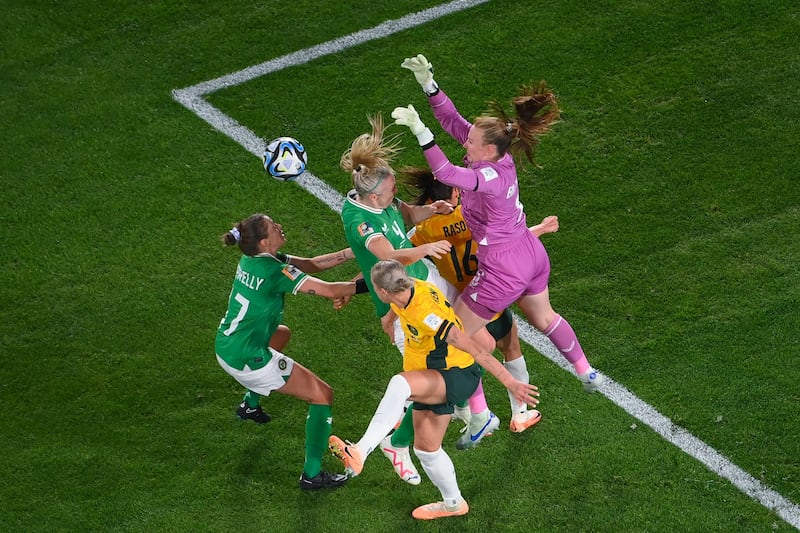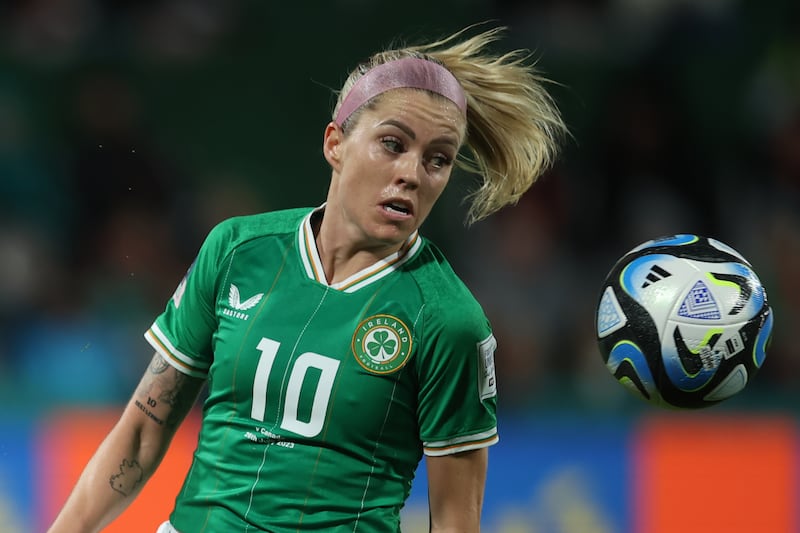The Republic of Ireland’s first Women’s World Cup is over and the players have arrived home with one point, two player-of-the-match awards and, mercifully, zero injuries. The homecoming turned O’Connell Street into a sea of green on Thursday evening, with fans of all ages coming out to hail the returning team.
Ireland will play again in seven weeks – in a Nations League tussle against Northern Ireland in the Aviva Stadium. In the meantime, there are lessons to be learned, videos to be reviewed and improvements to be made.
Although the results did not go the way of the Irish, history was made by Ireland’s first entry into the tournament and by the feats of some individual players. Encouragement can be taken from the performances, which were mostly honourable. And when we look at the numbers compiled by Stat Sports, it is clear that there was no shortage of effort in Australia.
Few substitutes got a real chance to make an impact off the bench,.so the following review looks only at players who started the games against Australia (0-1), Canada (1-2) and Nigeria (0-0).
Courtney Brosnan (Everton)
Ireland technically had nothing to play for against Nigeria, but were clearly desperate to come away with a win. Although they didn’t manage that, they did gain a point after a 0-0 draw, in no small part thanks to the efforts of player of the match Brosnan. The highlight of her crucial contribution was her save from an Uchenna Kanu header that would certainly have found the net if not for the goalkeeper’s intervention,. That stop helped to ensure Ireland did not return from the tournament without a point, and it also enabled Brosnan to rise to second on the women’s national team’s all-time list for clean sheets, with 11.

Louise Quinn (Birmingham FC)
An injury concern for the Birmingham skipper after the Australian match did little to put her off her game against Canada. Any doubts about her ankle were resolved when we saw how much she ran: a total of 10,336 metres, 1,623 of which were at high intensity. Her appearances in all three games brought her international cap tally to 108, making her the fourth most capped Irish women’s player.
Niamh Fahey (Liverpool)
The Galway-born Liverpool captain performed consistently well throughout the group stages. The Nigeria game marked her 111th cap, making her the third-most capped Irish international in the history of the women’s game. She was always exactly where she needed to be in defence during the games, and against Canada that meant clocking up a total of 9,944 metres.
Diane Caldwell (Reading)
A standing ovation welcomed the 34-year-old Dubliner into the Nigeria game as she replaced Fahey in the 90th minute for her 97th international appearance. Reaching that milestone was admirable – and would have been even more so if she really were 84 years old, as RTÉ commentator George Hamilton momentarily suggested.
Megan Connolly (unattached)
Unfortunately for Connolly, her most eye-catching moment in the World Cup was an unlucky own goal against Canada. That slip-up aside, she covered plenty of ground in that game, a total of 9,711 metres, to be precise.,
Ruesha Littlejohn (unattached)
To anyone who thought this tournament was to be Littlejohn’s swansong, her consistent performances across the three games showed she still has much to offer. Against Australia she ran 10,719 metres, including 384 at high speed. In the Nigeria match, only Sinead Farrelly surpassed her total of 10,380 metres covered at a maximum speed of 27.68km/h.
Denise O’Sullivan (North Carolina Courage)
Her three starting World Cup appearances made the North Carolina Courage captain the fifth most capped player in the Irish women’s game, with 105 caps to her name. Despite feeling pinned down in defence in the first two games, O’Sullivan ran 10,240 metres (1,960 at high intensity) and 11,069 metres respectively in them, hitting a maximum speed of 28.73km/h. She played in a more advanced role against Nigeria and ran 9,866 metres but was left ruing her failure to convert chances into goals.

Katie McCabe (Arsenal)
The Ireland skipper scored the only Irish goal of the three games, making it her 21st international goal, which put her second in the all-time scoring hierarchy for Irish women. One of a handful of Irish players who played every minute of all three matches, McCabe demonstrated the dynamism that fans have come to expect from her, ranking in the top five players in each game for running distance, speed and intensity. In her player-of-the-match performance against Canada, she clocked up 11,329 metres, 2,309 at high intensity. McCabe also received two yellow cards over the three games.
Lily Agg (unattched)/Lucy Quinn (Birmingham FC)/Marissa Sheva (Washington Spirit)
Marissa Sheva, Lucy Quinn and Lily Agg started a game each during the tournament. Sheva’s faux paus that led to an Australian penalty in the first match might have led to her being replaced by Quinn for the Canada game. In fairness, Quinn had made an impact off the bench in the opening game. Agg’s surprise start in the Nigeria game enabled O’Sullivan and Sinead Farrelly to move further up the pitch, giving Ireland more freedom to attack.
Heather Payne (unattached) /Áine O’Gorman (Shamrock Rovers)
Payne virtually never stops moving when she’s on a pitch and she performed with customary vigour against Australia and Nigeria, covering 10,380 metres (726 at high speed, with a)peak speed of 31.36km/h). She missed the Canadian game due to a hamstring injury, and was replaced by O’Gorman, who made her 119th international appearance, making her the second-most capped Irish women’s player, with only Emma Byrne (134 caps) ahead of her.
Sinead Farrelly (Gotham FC)
Having only made her debut in April, the US-born player proved she was worthy of a starting spot in each match of the campaign. She was particularly good against Nigeria, where she ran more than any other Irish player, covering an impressive 11,274 metres. Maybe that’s why Pauw didn’t think Farrelly needed to be replaced by someone fresher.
Kyra Carusa (London City Lionness)
Only recently confirmed as Ireland’s go-to striker, Carusa didn’t manage to get a goal. That wasn’t for the want of trying, though, and her threat was shown by bursts of speed that saw her reach 28.33km/h in the Australia game and 29.09km/h against Canada, faster than any other Irish player in the tournament. She was also in the top five for metres made against Nigeria with 9,916 metres made.
Substitutes:
Abbie Larkin, Amber Barrett and Izzy Atkinson also made appearances off the bench.





















